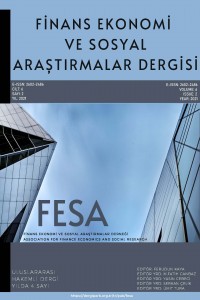Abstract
Bu çalışmada şirketlerin proje değerleme ve seçiminde daha sağlıklı, daha isabetli ve katma değeri yüksek proje seçmesini kolaylaştırma amacıyla geliştirilmiş yeni bir yaklaşım tanıtılmaktadır. Yatırım Net Getiri Oranı; proje değerlemesinde yatırım süresi, yatırım tutarı ve yatırım döneminden arındırılmış bir yaklaşım olarak, tüm projelerin aynı baza indirgenmesini sağlayarak birbirleri ile kıyaslamasını sağlayan bir yöntemdir. Bu yöntem aynı zamanda, en çok kullanılan değerleme prensipleri olan Net Bugünkü Değer, İç Getiri Oranı ve İskonto Edilmiş Geri Ödeme Süresi yöntemlerini kapsamakta ve birleştirmektedir. Geliştirilen bu yöntem örnek projeye uygulanmış ve elde edilen sonuçlar dikkate alınarak mevcut değerleme yöntemlerine göre üstünlükleri analiz edilmiştir.
References
- Afonso, P. & Cunha, J. 2009. Determinants of the use of capital investment appraisal methods: evidence from the field.Prague Czech Republic: European Applied Business Research Conference (EABRC).
- Akalu, M. 2001. Re-examining project appraisal and control: developing a focus on wealth creation. International Journal of ProjectManagement,19.
- Akpan, I. 2004. Fundamentals of finance. Uyo: Nelgrafik Nig. Limited.
- Brealey, R. and S. Myers 1998. Priciples of Corporate Finance. (5th ed.),McGraw-Hill.
- Damodaran A. 2011. Applied Corporate Finance, 3rd Edition, John Wiley & Sons.
- Damodaran A. 2001. Corporate Finance: Theory and Practice, 2nd Edition, John Wiley & Sons.
- Emekekwue, P. 2009. Corporate financial management. Congo: African Bureauof Education Science
- Farragher, E., R. Kleiman and A. Sahu 2001. The association between the use of sophisticated capital budgeting practices and corporateperformance.The Engineering Economist,46(4).
- Femi, A. A. & Oluwale, O. O. 2008. The importance of the payback method in capital budgeting decisions. School of Management, Bleking Institute of Technology.
- Gilbert, E. 2005. Capital budgeting: A case study analysis of the role of formal evaluation techniques in the decision making process. SA Journal of Accounting Research19(1).
- Longmore, D. 1989. The persistence of the payback method: a time adjusted decision rule perspective. Eng. Economist, 34(3).
- Mbat, D. O. 2001. Financial management. Uyo: Domes Associates Publishers, Nigeria.
- Pandey, I. M. 2008. Financial management. (9th ed). Vikas Publishing House Pvt Ltd.
- Remer, D. and A. Nieto 1995. A compendium and comparison of 25 projecte valuation techniques. Part 1: Net present value and rate of return methods. International Journal of Production Economics,42.
- Ryan, P. and G. Ryan (2002). “Capital budgeting practices of the Fortune 1000: How have things changed?” Journal of Business and Management 8(4)
- Steiner, M. (1996) Principles of Engineering Economics. McGraw-Hill.
Abstract
References
- Afonso, P. & Cunha, J. 2009. Determinants of the use of capital investment appraisal methods: evidence from the field.Prague Czech Republic: European Applied Business Research Conference (EABRC).
- Akalu, M. 2001. Re-examining project appraisal and control: developing a focus on wealth creation. International Journal of ProjectManagement,19.
- Akpan, I. 2004. Fundamentals of finance. Uyo: Nelgrafik Nig. Limited.
- Brealey, R. and S. Myers 1998. Priciples of Corporate Finance. (5th ed.),McGraw-Hill.
- Damodaran A. 2011. Applied Corporate Finance, 3rd Edition, John Wiley & Sons.
- Damodaran A. 2001. Corporate Finance: Theory and Practice, 2nd Edition, John Wiley & Sons.
- Emekekwue, P. 2009. Corporate financial management. Congo: African Bureauof Education Science
- Farragher, E., R. Kleiman and A. Sahu 2001. The association between the use of sophisticated capital budgeting practices and corporateperformance.The Engineering Economist,46(4).
- Femi, A. A. & Oluwale, O. O. 2008. The importance of the payback method in capital budgeting decisions. School of Management, Bleking Institute of Technology.
- Gilbert, E. 2005. Capital budgeting: A case study analysis of the role of formal evaluation techniques in the decision making process. SA Journal of Accounting Research19(1).
- Longmore, D. 1989. The persistence of the payback method: a time adjusted decision rule perspective. Eng. Economist, 34(3).
- Mbat, D. O. 2001. Financial management. Uyo: Domes Associates Publishers, Nigeria.
- Pandey, I. M. 2008. Financial management. (9th ed). Vikas Publishing House Pvt Ltd.
- Remer, D. and A. Nieto 1995. A compendium and comparison of 25 projecte valuation techniques. Part 1: Net present value and rate of return methods. International Journal of Production Economics,42.
- Ryan, P. and G. Ryan (2002). “Capital budgeting practices of the Fortune 1000: How have things changed?” Journal of Business and Management 8(4)
- Steiner, M. (1996) Principles of Engineering Economics. McGraw-Hill.
Details
| Primary Language | Turkish |
|---|---|
| Subjects | Business Administration |
| Journal Section | Araştırma Makaleleri |
| Authors | |
| Publication Date | June 30, 2021 |
| Submission Date | January 16, 2021 |
| Acceptance Date | April 29, 2021 |
| Published in Issue | Year 2021 Volume: 6 Issue: 2 |


